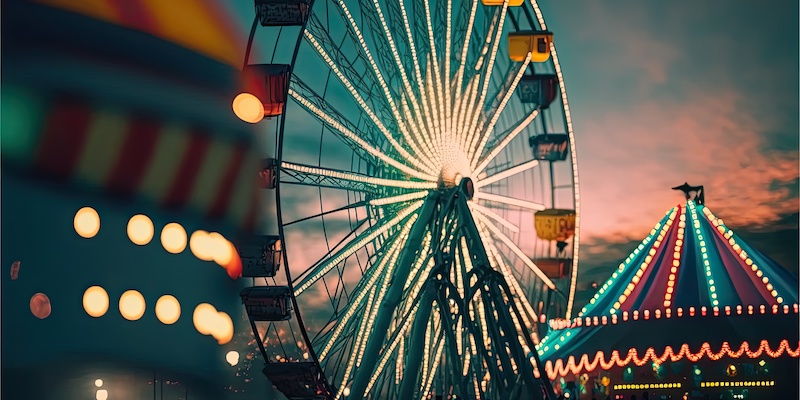Every town or county has its version. In all the corners of North America, for a short time each year, in mall parking lots or yellowing fields on municipal outer limits, an otherwise unremarkable space is transformed. The endless strings of incandescent lights with their sequenced colors. The tinny royalty free music and the roar of the rollercoaster. The smell of hot friar oil and the exhaust of diesel generators. Most of us have, in some corner of our mind, memories of our local carnival or fair.
In my hometown of St. Albert, Alberta, straddling the 53rd parallel north on the cusp of the Canadian prairies, we had the Rainmaker Rodeo. For one (true to the name and often rainy) weekend each May, between the commercial buildings of Riel Business Park and the pristine green fields of the rugby club, the city converged to take in the bull riding, mud bogging and the iconic Rainmaker midway.
I started young, much like the protagonists of my debut novel, Sunsetter, watching the chuckwagon races with my dad, taking in the parade with extended family in the shadow of the little white chapel at the foot of Seven Hills. Later, under the guise of middle school independence, my best friend and I would spend half a month’s paper route earnings and ride ourselves sick on the Gravitron and the Zipper. Later still, in my late teens and early twenties, that same best friend and I would stumble down the thoroughfare, drunk and uninhibited, blowing our money on mini donuts and rigged carnival games.
For several years, even before I began on my first draft of Sunsetter, I wanted to set a book in the transitory bubble of this small-time local rodeo, which seized upon our city for three days each year and then vanished, leaving only piles of garbage, the muddy tracks of semis and the churned earth of the field below the grandstand.
My debut novel doesn’t necessarily break ground with this sense of place in art or literature. An argument could probably be made for the creation of a genre of its own—the midway narrative—with memorable inclusions from across mediums, like Derek Cianfrance’s 2012 film The Place Beyond the Pines, HBO’s Euphoria SE01EP04: “Shook Ones Pt. II” or Joyland by Stephen King. But what makes these settings so appealing to authors and audiences alike?
Aside from the obvious points of artistic appeal, the storm of light and sound, there is a menace inherent in the concept of a midway that is a source of palpable tension in the narratives that choose to showcase it. After all, it’s a form of entertainment that finds its origins in the bloody circuses of Ancient Rome and the ‘freak shows’ of Barnum & Bailey. In it, we find a pressure cooker of potential conflict in the uneasy balance of a world taking form within another, one mundane and the other fantastic and unfamiliar.
Under the midway’s swirling lights, we find an important contrast in the shadows they create. The halogen floodlights might turn the muddy thoroughfare as bright as day, but an undeniable darkness forms between the tents and booths and beneath the creaking metal amusement rides. The same is true of the space beyond the midway, as a reverse event horizon takes shape around the bright iris of the carnival.
There’s also an important attitude to consider, one that dies hard in all small towns and cities, and that’s the fear of the other. It’s what makes middle class folks on cookie cutter suburban cul-de-sacs look unkindly upon strangers. It’s the pervasive othering that rightwing politicians capitalize on to push xenophobic policies and refuse action on gun legislation. And the traveling carnival, with its peripatetic staff and ephemeral structures, is an enterprise that historically and consistently embodies ‘the other’. When these fairs take place in our cities each year, we accept them for their novel offerings and entertainment value, but with the caveat that their strange world will not overstay its brief welcome or bleed beyond the borders of whatever parking lot or empty field we’ve allowed it. Consider it an extension of the mysterious visitor, the unwanted guest.
The midway’s offerings, too, are accepted only because they must come and go. The cheap thrills of amusement rides and deep fried foods are exactly that—cheap and thrilling—but they can’t last either. Carnival games are infantilized gambling with largely disposable prizes, and yet, for a short period, we say to hell with it and throw the dart at the wall of balloons. It’s indulgence with a well-defined beginning and end.
This temporary mental state can make us act in strange ways. We spend our hard earned money on small luxuries that exist outside our habitual realms of desire. We take a ride on the sketchy roller coaster, assembled only yesterday from the back of an eighteen wheeler. We allow ourselves to scream our lungs out from the top of the Ferris wheel. We have one more drink. Maybe another. It’s in this mental space that exists the narrative potential for unexpected actions from fairgoers who we might otherwise view as innocuous.
As an author, this is the phenomenon that drove the conflict in writing Sunsetter. Whether it’s a character whose nefarious tendencies are augmented in this suspension of norms, or your typical straight arrow who finds themselves transformed under the carnival lights, the midway as a setting offers us an atmosphere in which people can astound and shock us.
Symbolically and sensorially, the midway is the perfect setting to fuel the tension that permeates great thrillers and crime fiction. And it did not fail to surprise me throughout the writing process: with the dark corners it pushed my characters into, the decisions it forced them to make, the unfortunate anguish it put them through. I hope it will surprise you, too.
***


















